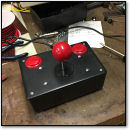 One of the best reasons to own a Jaguar circa 1994
One of the best reasons to own a Jaguar circa 1994
Twenty years ago this week, id Software launched one of the most important and influential PC games of all time: Doom. It started as a modest shareware download but grew to change the entire video game industry. To explain how, here’s 2009 Benj writing about the title for a PC World slideshow:
Id’s archetypical first-person shooter triggered a sea change in the PC game industry, which had formerly been dominated by slow, plodding strategy turn fests, brainy simulations, and stilted PC action titles of yore.
In contrast, Doom was the first of a new generation of fast-paced, smooth action titles that utilized new visual techniques to push PC hardware to its limits. With Doom, PC gamers could experience fluid gameplay, graphics, and sound that easily topped what was found on home game consoles of the day — an uncommon achievement at that point.
Moreover, it introduced exciting new network multiplayer options that are widely imitated to this day, coining the term “deathmatch” in the process.
From its lowly roots as a MS-DOS shareware title, Doom spread like a weed to other platforms, including game consoles, which now count first-person shooters as one of their best-selling genres.
“Doom defined the 3D shooter genre and made multiplayer gaming mainstream,” says Tim Sweeney (founder of Epic Games and creator of the Unreal Engine), “And it did them with such incredible polish, artistry, and foresight that it created an industry.”
Considering that Doom launched in 1993 via shareware channels, I’m not aware of when or in what publication the first advertisement for Doom appeared. (I believe GT Interactive became distributor for the full, boxed PC version of Doom much later, but I could be mistaken.)
So instead, I found this nifty November 1994 scan for the Atari Jaguar version of Doom. I received this version of the game for Christmas in 1994, and it was an amazing gift.
Pushing the PC Limits, Jaguar Relief
Most people don’t remember how much horsepower Doom required in a PC at the time — at least 4 MB of RAM, a mid-range 486 CPU, and a sound card to run passably well. So I had trouble running the game on any PC up to that point.
In 1993, we had one 486 in the household with exactly 4 MB of RAM (to contrast, my personal PC sported a 16 MHz 386 and 2MB RAM), and I had to make a special 5.25″ boot disk that loaded fewer resident DOS drivers, etc. so I could run Doom on that 486 at all. If I recall correctly, I didn’t have enough spare RAM to load the SoundBlaster drivers at boot, so the experience was limited. My friend had to run Doom on his mom’s 486 the same way. Even then, the game didn’t run at full frame rate. Doom pushed the limits.
So coming from that environment, it was an amazing convenience to just plug a Doom cartridge into the Jaguar and play, full-speed, full-screen, with glorious sound and no hiccups. My brother and I played a lot of Doom on that console well into 1996 — until I got a more powerful PC that could run Doom with ease.
Until the PlayStation port of Doom came out (late 1995), the Jaguar port was widely considered the best port of the game (in terms of screen window size, lighting effects, monster interaction, sound, controls, and frame rate) available on consoles. Its biggest drawback was lack of a soundtrack during gameplay. I think that’s because John Carmack used the Jag’s DSP co-processor to handle graphics routines instead of music, which was unconventional on that platform.
But I digress. What a great game. I still play Doom regularly via modern source ports on the PC — most recently on my new 1080p big screen TV set. Add on Xbox 360 controller support via ZDoom, and you’ve got Doom heaven. It’s a game that never seems to get old for me, even 20 years on. That’s the mark of a true classic in my book.
[ From Electronic Gaming Monthly, November 1994, p.109]
Discussion Topic of the Week: How did you feel when you first played Doom? What are your memories of the occasion?
 An early example of the rustic illustrated Christmas list
An early example of the rustic illustrated Christmas list


 Hello, and welcome to VC&G’s 2013 Thanksgiving Spectacular. I’m your host for this evening, Burt Edwards.
Hello, and welcome to VC&G’s 2013 Thanksgiving Spectacular. I’m your host for this evening, Burt Edwards.









